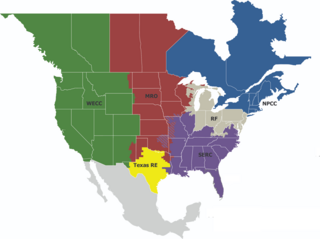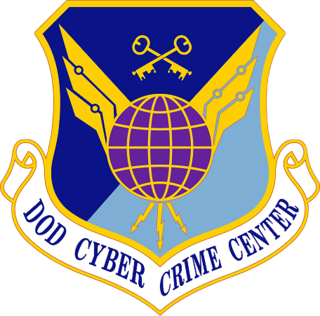Related Research Articles

The National Communications System (NCS) was an office within the United States Department of Homeland Security charged with enabling national security and emergency preparedness communications using the national telecommunications system. The NCS was disbanded by Executive Order 13618 on July 6, 2012.

The North American Electric Reliability Corporation (NERC) is a nonprofit corporation based in Atlanta, Georgia, and formed on March 28, 2006, as the successor to the North American Electric Reliability Council. The original NERC was formed on June 1, 1968, by the electric utility industry to promote the reliability and adequacy of bulk power transmission in the electric utility systems of North America. NERC's mission states that it "is to assure the effective and efficient reduction of risks to the reliability and security of the grid".

The United States Department of Homeland Security (DHS) is the U.S. federal executive department responsible for public security, roughly comparable to the interior or home ministries of other countries. Its stated missions involve anti-terrorism, border security, immigration and customs, cyber security, and disaster prevention and management.
The United States Computer Emergency Readiness Team (US-CERT) is an organization within the Department of Homeland Security’s (DHS) Cybersecurity and Infrastructure Security Agency (CISA). Specifically, US-CERT is a branch of the Office of Cybersecurity and Communications' (CS&C) National Cybersecurity and Communications Integration Center (NCCIC).

The National Cyber Security Division (NCSD) is a division of the Office of Cyber Security & Communications, within the United States Department of Homeland Security's Cybersecurity and Infrastructure Security Agency. Formed from the Critical Infrastructure Assurance Office, the National Infrastructure Protection Center, the Federal Computer Incident Response Center, and the National Communications System, NCSD opened on June 6, 2003. The NCSD mission is to collaborate with the private sector, government, military, and intelligence stakeholders to conduct risk assessments and mitigate vulnerabilities and threats to information technology assets and activities affecting the operation of the civilian government and private sector critical cyber infrastructures. NCSD also provides cyber threat and vulnerability analysis, early warning, and incident response assistance for public and private sector constituents. NCSD carries out the majority of DHS’ responsibilities under the Comprehensive National Cybersecurity Initiative. The FY 2011 budget request for NCSD is $378.744 million and includes 342 federal positions. The current director of the NCSD is John Streufert, former chief information security officer (CISO) for the United States Department of State, who assumed the position in January 2012.

The Homeland Security Act (HSA) of 2002, was introduced in the aftermath of the September 11 attacks and subsequent mailings of anthrax spores. The HSA was cosponsored by 118 members of Congress. The act passed the U.S. Senate by a vote of 90–9, with one Senator not voting. It was signed into law by President George W. Bush in November 2002.
The National Cybersecurity Center (NCC) was founded in 2016 as a 501(c)(3) nonprofit organization in Colorado Springs, Colorado. It was started from a vision of then Governor John Hickenlooper, in coordination with several people from the University of Colorado Colorado Springs (UCCS) and the community. The NCC serves both public and private organizations and individuals through training, education, and research.

The Department of Defense Cyber Crime Center (DC3) is designated as a Federal Cyber Center by National Security Presidential Directive 54/Homeland Security Presidential Directive 23, as a Department of Defense (DoD) Center Of Excellence for Digital and Multimedia (D/MM) forensics by DoD Directive 5505.13E, and serves as the operational focal point for the Defense Industrial Base (DIB) Cybersecurity program. DC3 operates as a Field Operating Agency (FOA) under the Inspector General of the Department of the Air Force.

The Command, Control and Interoperability Division is a bureau of the United States Department of Homeland Security's Science and Technology Directorate. This division is responsible for creating informative resources that strengthen communications interoperability, improve Internet security, and integrity and accelerate the development of automated capabilities to help identify potential threats to the U.S.

The National Cybersecurity and Critical Infrastructure Protection Act of 2013 is a bill that would amend the Homeland Security Act of 2002 to require the Secretary of the Department of Homeland Security (DHS) to conduct cybersecurity activities on behalf of the federal government and would codify the role of DHS in preventing and responding to cybersecurity incidents involving the Information Technology (IT) systems of federal civilian agencies and critical infrastructure in the United States.
Phil Agcaoili is a technologist, entrepreneur, and cyber security, information security, and privacy expert.

The Cyber Threat Intelligence Integration Center (CTIIC) is a new United States federal government agency that will be a fusion center between existing agencies and the private sector for real-time use against cyber attacks. CTIIC was created due to blocked efforts in Congress that were stymied over liability and privacy concerns of citizens.
An Information Sharing and Analysis Center(ISAC) is a organization that provides a central resource for gathering information on cyber and related threats to critical infrastructure and providing two-way sharing of information between the private and public sectors.

David J. Weinstein is an American cybersecurity executive and the former Chief Technology Officer of New Jersey. He previously served at U.S. Cyber Command.
The Center for Internet Security (CIS) is a US 501(c)(3) nonprofit organization, formed in October 2000. Its mission statement professes that the function of CIS is to " help people, businesses, and governments protect themselves against pervasive cyber threats."
The National Cybersecurity and Communications Integration Center (NCCIC) is part of the Cybersecurity Division of the Cybersecurity and Infrastructure Security Agency, an agency of the U.S. Department of Homeland Security. It acts to coordinate various aspects of the U.S. federal government's cybersecurity and cyberattack mitigation efforts through cooperation with civilian agencies, infrastructure operators, state and local governments, and international partners.

The New Jersey Office of Homeland Security and Preparedness leads and coordinates New Jersey's counterterrorism, cybersecurity and preparedness efforts throughout the State.
Phyllis Schneck is an American executive and cybersecurity professional. As of May 2017, she became the managing director at Promontory Financial Group. Schneck served in the Obama administration as Deputy Under Secretary for Cybersecurity and Communications for the National Protection and Programs Directorate (NPPD), at the Department of Homeland Security.

The Cybersecurity and Infrastructure Security Agency (CISA) is a component of the United States Department of Homeland Security (DHS) responsible for cybersecurity and infrastructure protection across all levels of government, coordinating cybersecurity programs with U.S. states, and improving the government's cybersecurity protections against private and nation-state hackers.
Operational collaboration is a cyber resilience framework that leverages public-private partnerships to reduce the risk of cyber threats and the impact of cyberattacks on United States cyberspace. This operational collaboration framework for cyber is similar to the Federal Emergency Management Agency (FEMA)'s National Preparedness System which is used to coordinate responses to natural disasters, terrorism, chemical and biological events in the physical world.
References
- ↑ Sullivan, S.P. (September 17, 2015). "Fighting hidden threats: Inside N.J.'s new cyber security command center". NJ.com. Retrieved January 23, 2016.
- 1 2 Christie, Chris. "EXECUTIVE ORDER NO. 178" (PDF).
- ↑ "Executive Order -- Promoting Private Sector Cybersecurity Information Sharing". whitehouse.gov . February 13, 2015. Retrieved January 23, 2016– via National Archives.
- ↑ Hayboer, Kelly (August 23, 2015). "Who hacked Rutgers? University spending up to $3M to stop next cyber attack". NJ.com. Retrieved January 23, 2016.
- ↑ Mathau, David (September 22, 2015). "Protecting Pope Francis from cyber threats". WKXW . Retrieved January 23, 2016.
- ↑ Nussbaum, Brian. "State-Level Cyber Security Efforts: The Garden State Model". The Center for Internet and Society. Stanford Law School. Retrieved January 23, 2016.
- ↑ Spidalieri, Francesca. "State of the States on Cybersecurity" (PDF). Pell Center for International Relations and Public Policy. Salve Regina University. Retrieved January 23, 2016.
- ↑ "NEW JERSEY CYBERSECURITY AND COMMUNICATIONS INTEGRATION CELL (NJCCIC) AND FS-ISAC PARTNER TO DELIVER CYBER THREAT INTELLIGENCE AND USE OF SOLTRA EDGE AT THE STATE LEVE" (PDF). July 8, 2015. Retrieved January 23, 2016.
- ↑ "NHISAC – NJCCIC and NH-ISAC Partner to Enhance Cybersecurity Information Sharing at the State Level". www.nhisac.org. Retrieved 2016-02-13.
- ↑ "NJCCIC Director Geraghty on CBS News New York during JerseyCTF". www.twitter.com. Retrieved 2023-06-22.